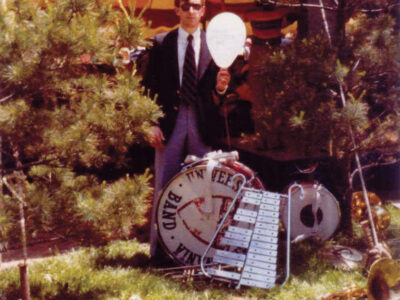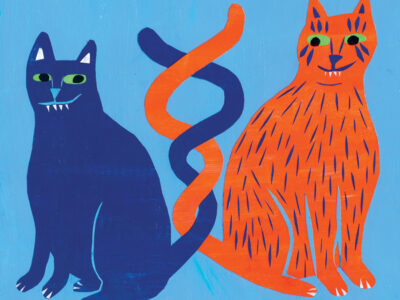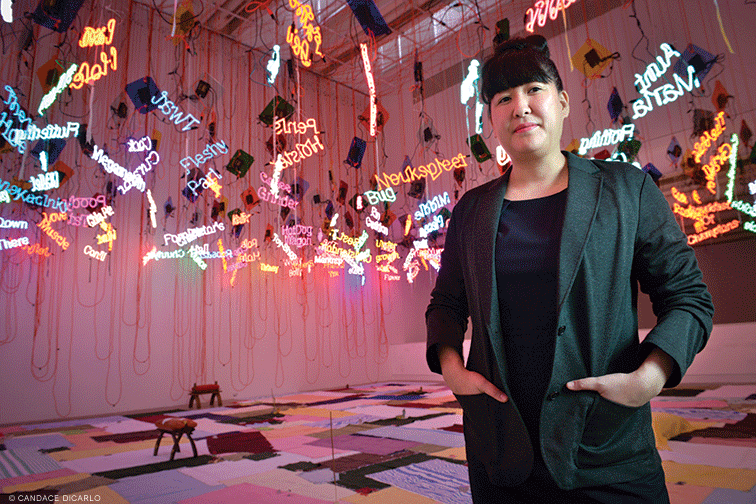
Penn’s Institute of Contemporary Art has been uncovering break-out artists and important trends for half a century. With a new director at the helm and a slate of ambitious exhibitions on tap for 2013-14, the museum is poised to celebrate its own past while still focusing on bringing what’s new in the art world to campus.
BY MOLLY PETRILLA | Photograph by Candace diCarlo
Sidebar | Remembering the Mapplethorpe Madness
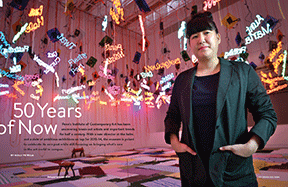
There’s diamond dust on the Institute of Contemporary Art floor. Some might call it fine-ground glass or grayish glitter but here in the ICA it’s diamond dust, no further explanation needed. It covers the concrete ground in swooping elliptical patterns as part of an installation by 31-year-old American artist Field Kallop. She uses homemade pendulums to scatter the sparkling debris while an audience watches each pattern slowly take shape. The tangles of fine lines are complete in about an hour, then they slowly disintegrate as visitors walk by, fading to near-invisibility over the course of a day.
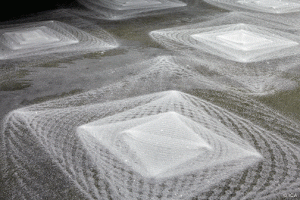
Looking down at the shimmering floor this past spring, ICA Director Amy Sadao, who joined the museum last fall, seems rather tickled by the whole thing. She says that the exhibition Kallop is part of, Glitter and Folds, was created to examine “glitter and the cultural capital of glitter.” She points to another piece in the show, Carter Mull’s photograph Pascal’s Wager (Dream of a Perfect Life), and notes the “interesting detritus” in the print—“all this glitter and decrepitude and decay.” Then she moves on, striding toward a large exhibition of work by the late photographer Brian Weil.
While Mull is a familiar name in the contemporary art world, this is Kallop’s first museum exhibition and Weil’s first career retrospective. But ICA has never shied away from firsts. As a result, there’s no way to predict what a visit to 118 S. 36th Street—the museum’s location since 1991—will turn up. Last winter, there were five bizarre handmade masks from a rapper-artist named Rammellzee and a giant black dress fashioned after a rotary telephone. In July, the second-floor gallery housed an airy-yet-enormous sculpture made from plaster powder and nail polish and bath bombs and Cellophane, assembled on-site by the Scottish artist Karla Black.
Nothing is taboo in ICA’s galleries. Sometimes that means a sexually explicit photo or painting; other times, it’s a G-rated tableau with two faux watermelons and Yugoslavian workers’ shoes in the center of a big round mirror. Chief Curator Ingrid Schaffner says the only thing she wouldn’t be willing to exhibit has nothing to do with graphic content or political correctness. Rather it’s “work by an artist who already has many opportunities to be seen in other places. We just wouldn’t see the point of doing that,” she adds. “We’re generally looking for the under-recognized established figure, or an artist who’s about to crest into bigger visibility but hasn’t quite yet.”
This academic year marks ICA’s 50th anniversary, making it older than Los Angeles’s Museum of Contemporary Art but younger than the Whitney in New York and Boston’s ICA. It’s an institutional rarity: an art museum without its own collection, focused strictly on contemporary work, plunked down in the middle of an Ivy League campus.
“We’ve far exceeded the idea of being a university museum,” Sadao says. “We’re more in line with international art centers and museums. When you look at ICA’s track record, it’s amazing to see how many times in the last 50 years ICA has presented work first, presented ideas first, and was ahead of the curve over and over again in identifying what was going to be important.”
In a 2009 review, New York Times art critic Roberta Smith seemed to acknowledge all of that, writing: “On a surprisingly regular basis, the tiny Institute of Contemporary Art … mounts exhibitions that make the contemporary art adventures of many larger institutions look blinkered, timid and hidebound.”
Katherine Stein Sachs CW’69, a member and former chair of ICA’s board of overseers,loves that quotation. She loves it so much that she carried it in her purse for months, the letters slowly fading. “There are many things that differentiate Penn from its Ivy League peers,” Sachs says, “and I think ICA is one of the most special.”
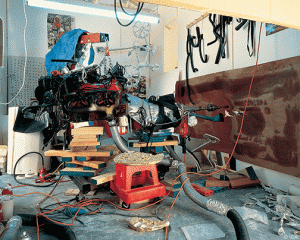
A TV twirls, an overhead projector whirls, and a model train chugs along its tracks. The giant mass of objects, which fills an entire gallery, also includes folding tables and desk lamps, large pieces of cardboard, a sewing machine, a mini-fridge, shredded paper, and whatever else might be hiding in there.
“Here’s the asshole,” curator Ingrid Schaffner announces cheerfully. “This steaming smoke machine. Every two minutes, it blasts out a beautiful smoke ring, which will float over the piece.” The tour group of ICA members and donors pause for a moment to watch a gray ring sail past the spinning TV.
It’s mid-September, opening night for Jason Rhoades, Four Roads, and this sculptural mishmash of everyday items—titled The Creation Myth— represents the artist’s brain and body at work. From now until December 29, it and three more of Rhoades’ massive works—along with a selection of smaller pieces—will fill nearly every inch of ICA’s 10,000-square-foot gallery space, kicking off the museum’s 50th anniversary year.
About six months earlier, Sadao said that the Rhoades show would be “in many ways the most ambitious exhibition that ICA has ever produced. It’s really going to stretch the institution in incredible ways.” As fall approached, she followed up with: “It’s the biggest show we’ve ever done, both in terms of content and resources. It’s ambitious because Rhoades’s work is ambitious. It’s big because Rhoades’s work and visions were big. It’s challenging because Rhoades’s work is challenging.”
It’s so challenging that Schaffner developed four “interpretive inroads” to help befuddled visitors better understand the works: (1) Jason Rhoades, American Artist; (2) systems; (3) Jason the Mason; and (4) taboo. She even created a tidy chart that outlines how each work intersects with all four “roads.”
Though Rhoades lived and worked in Los Angeles, he never hit it big as an artist in America. He instead carved out a sizable career in Europe, exhibiting there many times before his death at age 41 from a drug overdose in 2006. As ICA’s chief curator, Schaffner is the driving force behind this Rhoades show — the first major American museum exhibition of his work. She’s been hooked ever since she discovered Rhoades’s work at a New York exhibition in 1993. “It just blew me away,” she says. “I immediately started thinking about and working on Jason’s work.”
While he may not be a household name, Rhoades’s work resides in major contemporary museums around the country: New York’s Museum of Modern Art, Whitney Museum of American Art, and Solomon R. Guggenheim Museum; the Los Angeles County Museum of Art (LACMA) and the L.A.-based Museum of Contemporary Art; and the San Francisco Museum of Modern Art.
“There’s a real urgency to bring Jason’s work forward and open it up,” Schaffner says. “Looking at a picture in a book just doesn’t do it justice. Jason was a sculptor because he wanted you to be in the work and to be overwhelmed by it and to give yourself up to the experience of it.”
One particularly interactive piece in the show is Untitled (from My Madinah: In pursuit of my ermitage …). It covers a gallery floor with towels that have been hot-glued together, scattered incense holders, and a few small benches, simultaneously invoking a Middle Eastern bazaar and a mosque.
“Culturally, the power of the taboo is something that Jason harnessed and used, spectacularly so here with My Madinah,” Schaffner says, standing beside the sea of towels. More than 100 illuminated neon words hang from the ceiling: turnpike; breakfast of champions; love muscle; the unmentionable. “What are the words?” she says. “The words are ‘pussy words’—euphemisms that Jason Rhoades was collecting to build his ‘pussy lexicon.’” She encourages visitors to take off their shoes, tramp across the towels and lie on their backs, gazing into the sexually charged neon “sky” above. As soon as the invitation is issued, many people on the tour do just that.
Off to the side of the proceedings, Amy Sadao watches everything unfold with a smile. The ICA’s director looks every bit the art-world-mover-and-shaker tonight, dressed in a quirky plaid suit and flame-red top, her straight black hair pulled into a high bun.
While she’s now the head of a respected museum, Amy Sadao wasn’t born with a paintbrush in her hand or a Picasso over her crib. Her parents weren’t artists or curators but rather an optometrist (Dad) and a Los Angeles public-school teacher (Mom). Yet Sadao found herself drawn to art from a young age. She’d visit museums with her aunt and occasionally skip school to browse the Temporary Contemporary museum, now known as the Geffen Contemporary, in Los Angeles. There and in the Orange County Museum of Art and LACMA galleries, she’d look at works by Ellsworth Kelly and Frank Stella and Agnes Martin and try to figure out what made it all so electrifying—how these works she didn’t even understand could be so thrilling and invigorating.
But there was only so much art to experience and comprehend as a teenager in sunny, wealthy Orange County. (“I remember really understanding David Hockney’s pool series,” Sadao says with a laugh.) That is, until she began babysitting for an artist couple who had lived all over the world and produced “very conceptual” work. They gave her art books to read and talked to her about their work, encouraging Sadao to think beyond the local beaches and shopping malls.
She began to consider colleges and ultimately landed at Cooper Union in New York. Admission involved a 30-day home test. “I’m sure I had some drawings and collages that were very charmingly derivative homages to contemporary artists I was seeing in Southern California,” she says, chuckling again.
At Cooper Union, Sadao was surrounded by rising stars. She made art next door to Wangechi Mutu, who is now considered one of the most important African artists working today, and shared a dorm room with Kristin Lucas, who exhibited at ICA in 2000. But now that she was surrounded by dedicated artists, “I realized very early on that I was not going to be a practicing artist,” Sadao says. “I didn’t want to be alone in my studio. I’d spend more time watching [other artists’] progress, talking to them and writing about the work they were doing than I did making my own work.”
After working for several prominent curators and earning a master’s degree in race theory from UC Berkeley, she landed at Visual AIDS in 2002. Based in New York City, the 25-year-old institution bills itself as the only contemporary arts organization “fully committed to HIV prevention and AIDS awareness through producing and presenting visual art projects, while assisting artists living with HIV/AIDS.”
Sadao turned the organization’s $40,000 cash deficit into a balanced operating budget in her first two years as executive director. She’d tripled that budget by the time she left. In her decade at Visual AIDS, she also commissioned nearly 40 works by contemporary artists, oversaw 30 exhibitions and produced more than 100 web exhibitions. It all helped significantly raise the institution’s public profile.
When an advisory committee set out to replace Claudia Gould, who served as ICA’s director from 1999 through late 2011 and left to become head of The Jewish Museum in New York, Sadao stood out. “Her enthusiasm is amazing,” says Sachs, a member of the search committee, “as is her sense of community and her knowledge of contemporary art. Those three things hit us right away. Then we were also struck by how much the idea of working in an institution like ICA meant to her.”
And what does it mean? Inside her office, which is still on the empty side and overlooks a bustling 36th Street, Sadao explains: “ICA at Penn has meant a lot to me throughout my career. I always watched what ICA did and wondered how they could do it. There aren’t many other institutions I would have left Visual AIDS for,” she adds, “but leading ICA is a once-in-a-lifetime opportunity.”
ICA’s 50 years on the bleeding edge of contemporary art have provided some pretty crazy stories, but it’s hard to find anything that eclipses a zany night in early October, 1965.It was the opening of Andy Warhol’s first museum exhibition, presented by ICA inside the Furness building, now home of the Fisher Fine Arts Library. Anywhere from 1,600 to 4,000 people packed the museum, depending which reports you read. Whatever the exact number, the mob far surpassed the small space’s 300-person capacity.
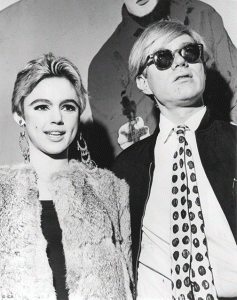
When Warhol arrived with a silver wig on his head and ’60s It-Girl Edie Sedgwick on his arm, the crowd went crazy. People swarmed the couple, thrusting Campbell’s soup cans and S&H Green Stamps at Warhol and begging him to sign them. With the museum’s young director Sam Green acting as a quasi-bodyguard—a quasi-bodyguard with Warhol’s signature Green Stamps silk-screened onto his tie, thankyouverymuch—the couple climbed up a metal staircase to escape. Unfortunately for the alarmed duo, it turned out that staircase didn’t actually go anywhere.
Eventually someone managed to saw through the ceiling, allowing the artist and his entourage to flee through the rare books room, up onto the building’s roof and down the fire escape. The night became an infamous story, later retold by numerous attendees, Green, and even Warhol himself. (“We weren’t just at the art exhibit,” the latter recalled, “we were the art exhibit.)
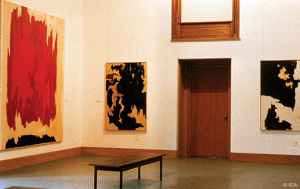
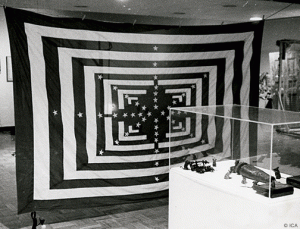
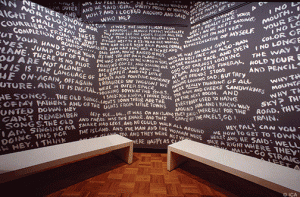
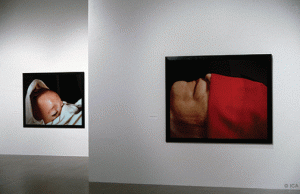
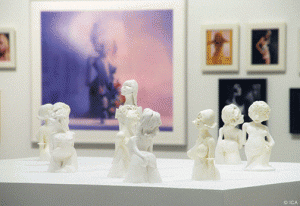
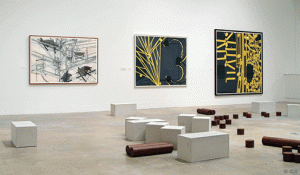
The exhibition and its chaotic opening night marked a major shift for all involved: from artist to megawatt star for Warhol; from upstart contemporary museum to serious art-world player for ICA. (It’s worth noting, too, that the ICA walls were lined with some of Warhol’s most famous works for that show, including “200 One Dollar Bills,” which sold for $43.76 million at Sotheby’s in 2009.)
The exhibition became a defining event for the young museum, which had been founded just two years earlier by G. Holmes Perkins Hon’72, the architect who headed Penn’s Graduate School of Fine Arts. At its inception, the ICA was “an attempt to fill the gap in the Philadelphia art scene” and introduce students to contemporary work, a 99-year-old Perkins told the Gazette in 2004. “Modern art was important and we weren’t giving it enough attention.” (After a few years in Furness, the ICA was moved to Meyerson Hall in 1968. Since 1991, it has occupied its current purpose-built home at 36th and Sansom streets, designed by Adele Naude Santos GAr’68 GCP’68 GFA’68, who had headed Penn’s Department of Architecture from 1981 to 1988.)
The first ICA show, in 1963, presented Clyfford Still, an abstract expressionist. With the installation of Green as director from 1964-67, more works from a fleet of soon-to-be superstars passed through the museum: Roy Lichtenstein, Ellsworth Kelly, Willem de Kooning, Jackson Pollock.
While Green may have set the stage, the parade of standouts continued long after his brief tenure. Abstract painter Agnes Martin picked up her brush for the first time in seven years after ICA showed her work in 1971. In 1977, Paul Thek returned to America from nearly a decade in Europe for ICA’s Paul Thek/Processions. In between, the museum helped introduce Cy Twombly, now famous for his mammoth scribbles, to the world. ICA also organized important solo shows for experimental performance artist and musician Laurie Anderson (1983), photographer Andres Serrano (1994), painter Lisa Yuskavage (2000), and sculptor Barry Le Va (2005).
Four Roads is one of the rare instances when the artist in a solo ICA show isn’t there to hobnob at the opening or help with the installation process. “Pretty much 24/7 we’re working with living artists,” Schaffner says. “That’s why we all love working here. Artists come first, and you’re often helping to support and facilitate their ideas, projects, or ambitions.”
The museum’s current crop of curators and staff pride themselves on still presenting firsts, whether it’s an artist’s first major exhibition or the first time a new trend appears in the art world or simply the first time a piece is seen by a wider audience. The museum’s director and curators “know what’s going on and who’s doing it and who’s good at it,” Sachs says. “ICA doesn’t really show people who are what I would call one-liners—people who you forget about,” she adds. “There’s depth in their work, depth in their thinking, and it makes the art last and the experience of the art itself last for the viewer.”
“It’s often the case that art, artists, and exhibitions that are celebrated at the ICA go on to experience a huge renaissance in their careers,” ICA board member Arthur Cohen C’82 says. “I think the art world recognizes that the ICA has this wonderful ability to suss out what’s new, what’s important, what needs to be reconsidered.”
Sachs recalls a sound-focused exhibition that artist Christian Marclay guest curated for the museum in 2007. “I just read in the New York Times that now sound installations are a big thing in some of the New York museums,” she adds, “but ICA did it six years ago.”
When curators set out to plan a 50th-anniversary exhibition for the 2013-14 academic year, they wanted to honor the institution’s history but still keep a focus on what’s fresh and new. It felt wrong to bring a strictly historical exhibit into a contemporary museum.
They settled on ICA @ 50: Pleasing Artists and Publics Since 1963—a series of 20 “micro-exhibitions” that will begin February 12. “We decided as a curatorial team that we want to learn about what we don’t know about ICA’s past,” Schaffner says. “This was a chance to be like, ‘What was this show called Some Twenty Odd Visions that took place in 1978?’”
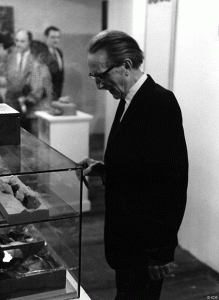
Schaffner will begin by looking at The Other Tradition, a show that the radical art historian Gene Swenson organized in 1966. The show examined pop art through surrealism, which was “almost like a sin” in the late ’60s, Schaffner says. There’s only one photo from the exhibition: a snap of artist Marcel Duchamp looking at malic-acid moulds in a display case. She’s hoping to somehow round up a handful of objects that were either in the original show or directly relate to it.
“The idea is that the past becomes a springboard into the present for these projects,” Schaffner says. “It will be very dynamic. We were never just going to have 50 shows on the second floor trying to recreate past moments.”
As a freshman at Penn, David Galperin C’13 W’13 jetted off to the bi-annual Venice Biennale, a major contemporary art exhibition, over his fall break. Chloe Kaufman C’16 spent her first undergraduate year planning and mounting a contemporary art show, and the year before that, 12 freshmen dug into the archives from that wacky Warhol night and produced a museum exhibition and book on the subject.
Through the annual Spiegel Freshman Seminar in Contemporary Art, small batches of Penn students become curators, art historians, and close friends of the ICA. Both the Warhol show and the one Kaufman helped organize last year—Each One As She May: Ligon, Reich, And De Keersmaeker—were on view in the museum, right alongside shows that ICA’s most senior curators had developed.
“These classes are very special and not something I ever experienced as an undergraduate or even a grad student,” says Gwendolyn DuBois Shaw, an associate professor and undergraduate chair in the art history department, who taught the seminar last year. “Not only do students have the opportunity to work with objects in museums and galleries, but they also have this pre-professional experience that you wouldn’t necessarily expect a department in the humanities to offer. The students figure out what they need to know for the future: what kind of graduate degree they want to pursue, whether they want to intern in a museum during the summer.”
But those freshman contemporary art seminars are small and send only a handful of undergrads into the ICA each year. It’s been a long-standing challenge to get the rest of the student population inside. There are student-centered events and special lectures, a student advisory board and extra-credit assignments, but “it’s hard to capture the attention of these extremely ambitious and over-programmed Penn students,” Sadao says. “Having ICA here is a bit like having a little Whitney or Tate Modern two blocks from your chemistry class, and yet the recognition in the world is probably greater than the recognition here at Penn.”
As Galperin puts it: “My friends who weren’t involved with ICA didn’t know about it, which shocks and fascinates me all the time. I always had to explain what it was and point to its location as being ‘next to Urban Outfitters,’ which is ridiculous to me.”
Sadao is hopeful, though. She recently saw some of the attendance data from last winter and the numbers are encouraging: In her first four months as director, twice as many Penn students visited ICA than in the previous quarter.
“That was without applying resources or hiring anyone new,” she adds. “It was from my interest in going across this campus and meeting with professors and department chairs and administrators and student leaders, making invitations, reminding them of or inviting them to the extraordinary contemporary art museum on their campus.”
“If I were a student,” Sadao muses at one point, “I would come here weekly.” There are certainly those who do. Between his art history studies and his place on the ICA student advisory board, Galperin spent countless hours inside the museum during his time at Penn. He even completed a short internship there this past summer before heading off to a program at Sotheby’s. While Galperin entered Penn as a Wharton student, his experience with ICA inspired him to leave with a degree in art history as well as one in accounting.
Even for those who aren’t pursuing careers in the art world, ICA can serve an important function. “I think that at ICA, students can see the kind of ideas percolating out there that are going to be part of the world into which they graduate,” Sachs says. “One of the greatest things you can do for students is to help them think creatively.”
Yet Sadao recognizes that, whether student or general public, not everyone digs contemporary art. She admits that sometimes it’s hard to get those doubters through the front doors. The genre “can be challenging, and it should be,” she says. “That’s why we’re interested in it. As a viewer, you might have to be uncomfortable with the work for a while. There isn’t an answer; it’s not a riddle.”
“Some works require us to go and do some more research,” she adds. “That’s on us as the viewer. It’s on the artwork itself to be interesting enough or compelling enough or confounding enough or beautiful enough to make us want to learn more and to engage it further.” And when it comes to viewing art, adds Sachs, “Whatever you learn from it, whatever you take from it, is more than you had when you came in.”
While the difficulty of some work may be a barrier, cost isn’t—for students, or anyone else. The museum, as its tagline states, is “Free for All,” which has been the case since 2008, when Glenn Fuhrman W’87 WG’88 made a donation to underwrite admission and ICA stopped charging its previous $6 admission fee.
“But the tagline doesn’t just mean that we have no entrance fee,” Sadao adds. “It’s also an opening and an invitation. You’re free to agree or disagree with this work. You’re free to say, I don’t like this, I don’t understand this, or I absolutely love this.”
Back at the Rhoades tour, there is no shortage of mind-opening work to contemplate. In a few hours, more guests will start to arrive: artists, students, collectors, art lovers from throughout the region. Some of them will look at this latest ICA offering—this larger-than-life work with the smoke-blowing “asshole”—and echo a comment overheard on the donors’ tour: “I’m going to have to come back at least one more time. Once isn’t enough to digest all this.”
There’s no doubt Schaffner and Sadao and the rest of their team would take that as high praise—and strong evidence that ICA is still surprising, confounding and interesting visitors a full 50 years after it began.
Molly Petrilla C’06 is the Gazette’s arts blogger and a frequent contributor.
Oral History
Remembering the Mapplethorpe Madness
Judith Tannenbaum, a curator, associate director, and twice-interim director for ICA, recalls a major moment in the museum’s history.
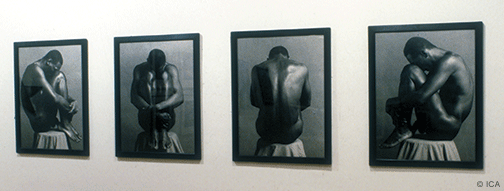
“I worked at the ICA for 14 years—1986-2000 — so there certainly were a lot of things that were memorable. But in terms of history, the biggest thing was the Mapplethorpe controversy. That was a huge national event and the repercussions are still going on.
In 1989, we’d gotten a grant from the National Endowment for the Arts to do a Robert Mapplethorpe exhibition. We opened the show and everything was fine. It was a traveling show, so it went to a couple of other museums. Then it was supposed to open in Washington, DC, at the Corcoran Gallery of Art. There was a new director there—and the NEA was coming up for refunding that summer in Congress—and she thought there might be problems because of the content of the show. Mapplethorpe did series that were based on his own life as a gay man, and there were some S&M images and also two images of children.
The Corcoran decided to cancel the show. It was really the cancellation of the show that caused this enormous media blitz and international brouhaha over NEA funding for the arts and what was appropriate, what tax dollars should be spent on. Jesse Helms, who was then a senator, took it up as a cause and it just really snowballed and became a huge issue.
Every time the show traveled to a new venue, there was a new story. When it went to Cincinnati, it became the center of a court case because the county there brought a suit against the director of the Cincinnati Contemporary Art Center. They were accused—and acquitted—of pandering pornography.
The ICA had organized the show, so we were really at the center of the whole thing. It went on very intensively for about two years because there were so many related legal battles. It was really about freedom of artistic expression. I felt there was no reason for us to censor the show. The University backed us wholeheartedly because they’re an educational institution. The then-president was Sheldon Hackney, who was very supportive.
I’d say we probably won the battles but lost the war—because arts funding really was dramatically cut back on a national level, on state levels, on local levels. The damage was really significant.
In 2010, the ICA in conjunction with the Pew Research Center organized a symposium and two-day program looking back 20 years after to try to re-evaluate what had happened. In terms of the museum, we came out okay. But that was by far the most memorable thing that happened while I was there.”



